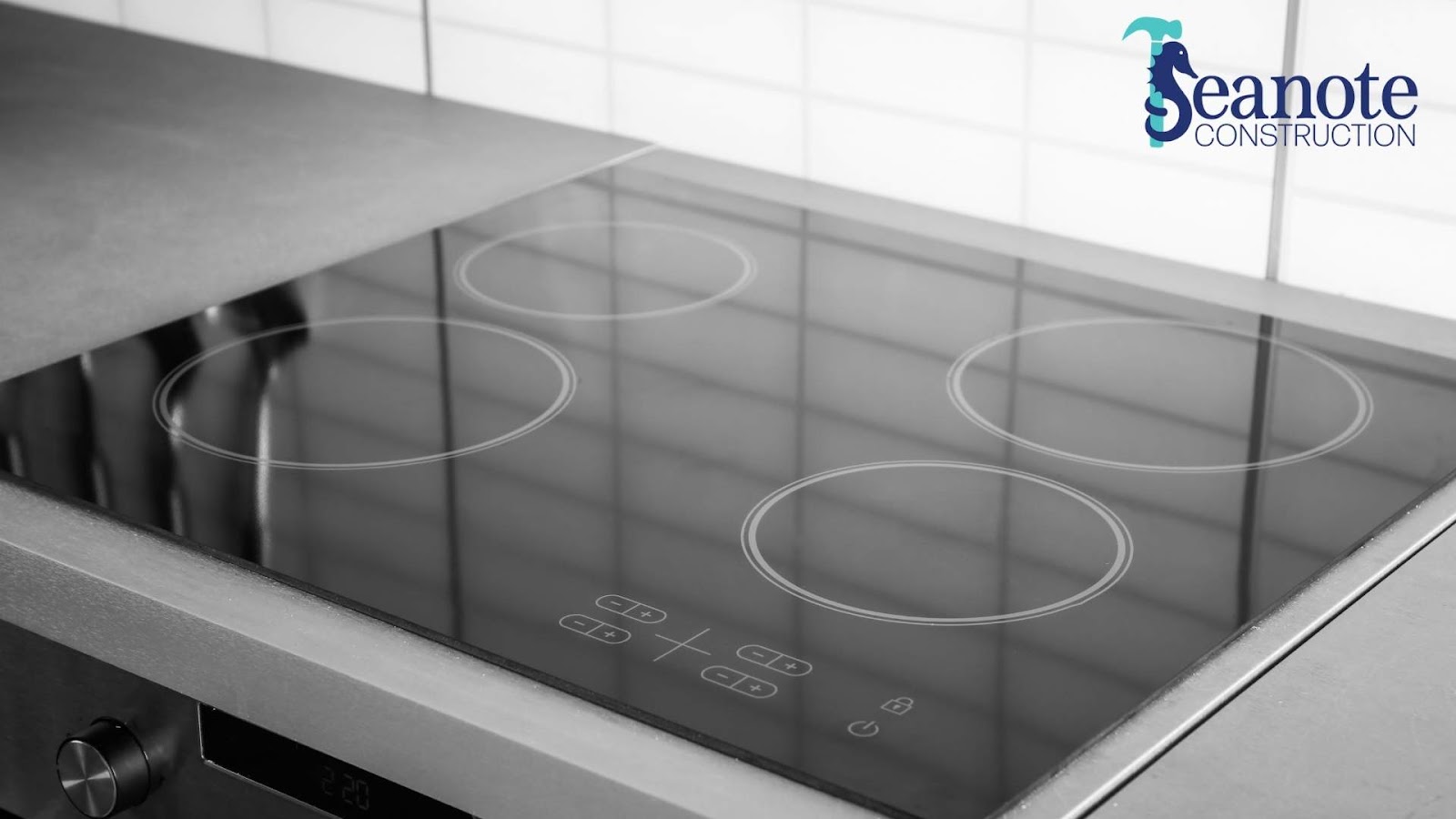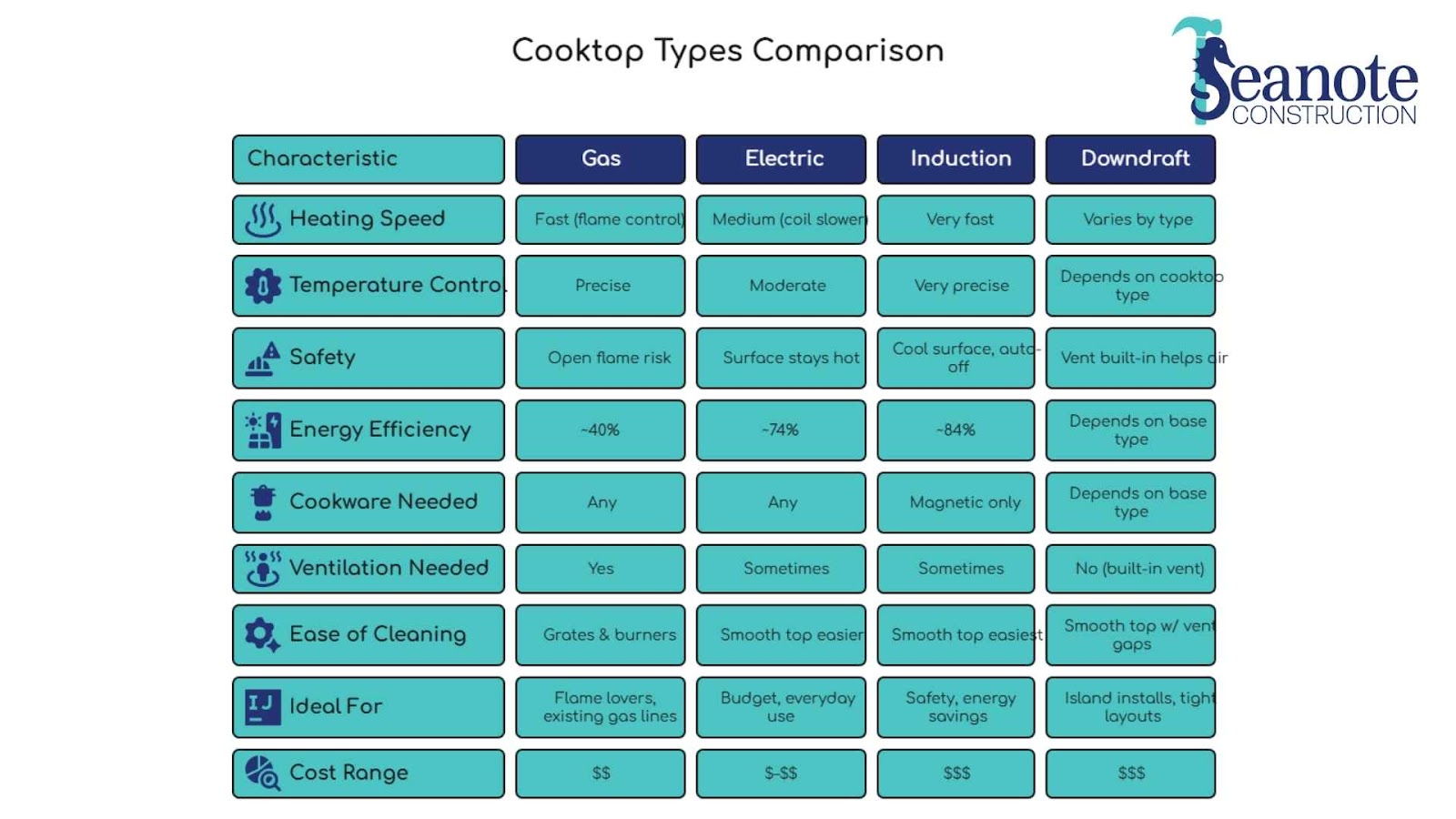Looking to remodel your kitchen but unsure which type of cooktop or stovetop fits your needs? If you’re an avid home chef or just want something sleek and safe for the family, choosing the right option can make a big difference in your daily routine.
At Seanote Construction, we have helped homeowners in Gainesville, Ocala, and surrounding areas find smart solutions tailored to their kitchens. We believe in clear, honest advice, especially when it comes to upgrades that impact how you cook, live, and feel in your space.
Key Takeaways:
- Cooktops offer flexibility and design freedom compared to ranges, allowing you to separate the oven and optimize kitchen layout for functionality and style.
- Gas, electric, and induction cooktops each have distinct pros and cons, with gas excelling in control, electric in affordability and simplicity, and induction in speed, safety, and energy efficiency.
- Choosing the right option depends on cooking habits, energy priorities, and space considerations, with downdraft systems providing a space-saving ventilation alternative for modern kitchen designs.
What Is a Cooktop or Stovetop?
A cooktop, also called a stovetop, is a built-in cooking surface that’s installed directly into your kitchen countertop, unlike a range, which combines a cooktop and oven in a single unit. If you’re remodeling your kitchen and want a sleeker or more flexible layout, a separate cooktop lets you place your oven elsewhere or skip it entirely.
Difference Between Cooktop vs. Range
The key difference is how the appliances are configured. A range combines the cooktop and oven into one freestanding appliance. A cooktop is just the top surface and gives you more design options, especially if you want wall-mounted ovens or extra storage below.
Ranges are a great all-in-one solution, but many kitchen remodels prioritize flexibility. That’s where cooktops shine.
Understanding Gas Cooktops
Gas cooktops use open flames and offer instant heat control, making them a longtime favorite among serious home cooks. If you love the visual cue of a real flame and want precise control over cooking temperatures, gas might be your go-to option.
Pros and Cons
Pros:
- Instant temperature control and responsive heat changes
- Works with all types of cookware
- Still works during power outages
Cons:
- Higher indoor air emissions, studies link gas stoves to 10–25 times more pollutants like NO₂ and benzene compared to electric models
- Requires gas line installation (if not already present)
- More difficult to clean due to grates and burners
According to Stanford researchers, gas stoves leak more methane than originally thought. That’s something worth considering if indoor air quality or sustainability is a priority for your family.
Best For
Gas cooktops are ideal for:
- Home chefs who want quick, visible flame control
- Homes with existing gas lines
- Homeowners in areas where power outages are frequent
Understanding Electric Cooktops

Electric cooktops are a solid choice for many homeowners because they’re widely available, easy to use, and don’t require a gas hookup. These units use electricity to heat either a metal coil or a glass-ceramic surface with radiant elements beneath.
Coil vs. Smooth Top
- Coil cooktops feature exposed metal burners and are usually more budget-friendly. They’re durable but slower to heat and harder to clean.
- Smooth top (radiant) cooktops use a flat glass surface with hidden heating elements. They offer better aesthetics and easier cleaning, but the glass can scratch or crack if mishandled.
Pros and Cons
Pros:
- Widely available and often more affordable than gas or induction
- No special cookware required
- Smooth tops are easy to clean and provide a modern look
Cons:
- Slower to adjust heat levels compared to gas or induction
- Coil versions can be harder to clean and less energy-efficient
- Surface stays hot long after cooking, which may be a safety concern
According to LeafScore, electric coil cooktops transfer around 74% of energy to cookware, compared to only about 40% with gas.
Best For
Electric cooktops work well for:
- Homeowners without a gas line
- Those who prioritize a clean, modern appearance
- People who want a lower-cost option that doesn’t require specific cookware
For many remodels, especially in Florida homes where energy costs and safety matter, electric cooktops offer a nice balance of simplicity and function.
What are Induction Cooktops?
Induction cooktops use electromagnetic energy to heat your cookware directly, without heating the cooktop surface itself. This makes them incredibly efficient, fast, and safe. If you want cutting-edge performance and don’t mind a slight learning curve, induction is worth a close look.
How It Works
Instead of generating heat through gas or electric coils, induction cooktops create a magnetic field that heats the pot or pan directly. The cooktop surface stays relatively cool since only the cookware gets hot. That’s a huge safety plus, especially for families with kids or aging adults.
You’ll need compatible cookware: magnetic stainless steel or cast iron. Aluminum, copper, or glass pans won’t work unless they have a magnetic base.
Safety and Efficiency
Induction is one of the safest and most efficient options available:
- Transfers about 84% of energy directly to cookware, according to Energy.gov
- The surface remains cool to the touch, reducing burn risk
- Automatically shuts off when cookware is removed
These features make induction ideal for energy-conscious households and anyone who wants to avoid open flames or lingering hot surfaces.
Best For
Induction cooktops are perfect if:
- You prioritize energy efficiency and faster cooking
- Safety is a top concern (kids, pets, aging in place)
- You’re open to investing in compatible cookware
More and more Florida remodels now include induction, especially for aging-in-place designs or modern kitchens that need sleek, safe functionality.
Understanding Downdraft Cooktop
Downdraft cooktops come with built-in ventilation systems that pull steam, smoke, and odors downward instead of requiring an overhead range hood. This type of cooktop is ideal for kitchens where wall or ceiling ventilation isn’t practical.
When Ventilation is Built-In
Downdraft systems use fans to pull air through vents located next to or in the center of the cooktop, directing it through ductwork below the cabinet. This setup eliminates the need for an overhead hood and can simplify your kitchen remodel, especially in island installations or homes with limited wall space.
These cooktops are available in gas, electric, and sometimes induction formats, though the downdraft element may slightly reduce cooking power or speed.
Space-Saving Benefits
In tight or open-concept kitchens, downdraft units offer serious advantages:
- Great for islands or peninsula layouts
- Creates a cleaner visual line without a bulky hood
- Allows more upper cabinet space in smaller kitchens
As reported by Verified Market Reports, the U.S. downdraft cooktop market reached $1.5 billion in 2024 and is projected to grow. This steady demand reflects their value in space-conscious kitchen designs, especially in remodels where aesthetics and layout flexibility are top priorities.
How to Choose the Right Cooktop for Your Kitchen

Choosing a cooktop is about how you cook, who you cook for, and how your kitchen is laid out. Here’s how to decide what’s right for your remodel.
Space and Layout Constraints
If you’re remodeling a compact kitchen or adding a cooktop to an island, induction or downdraft models are worth considering. Downdraft options eliminate the need for a range hood, freeing up cabinet space and making island installations cleaner and easier. Electric smooth tops also work well in tight layouts due to their flat design and lack of extra ventilation.
Cooking Habits
- Love to sauté and simmer? Gas offers flame control and responsiveness.
- Mostly boil, reheat, or simmer gently? Electric will do the job.
- Cook fast meals and want efficiency? Induction is the fastest and safest.
Think about how often and how intensely you cook. If your kitchen gets daily use, speed and cleanup matter more than you think.
Energy Use and Cost
If energy efficiency or monthly utility bills are top of mind, induction comes out ahead.
Also, consider the total install cost:
- Gas may require a new line.
- Electric is often the least expensive upfront.
- Induction may cost more initially but saves in long-term energy.
Safety and Family Considerations
For families with young children or older adults, safety is key. Induction cooktops stay cool to the touch and shut off automatically, features that significantly reduce burn risks. Gas, while powerful, involves open flames and residual heat from grates, which can be a concern.
If safety is a major priority in your remodel, induction leads the way. It’s also a great option for aging-in-place upgrades, something Seanote Construction handles for homes across Gainesville and Ocala.
Need Help Choosing the Right Cooktop for Your Kitchen?
Remodeling your kitchen is about building a space that works for your life. Regardless of if you’re leaning toward gas for its precision, electric for its simplicity, or induction for safety and efficiency, Seanote Construction is here to help you get it right.
We’ve completed custom remodels for families across Gainesville, Ocala, and the I-75 corridor, always with a focus on clear communication and craftsmanship that lasts. If you’re planning a kitchen upgrade and want honest guidance from a team that does the tough jobs right, we’re ready when you are.
Contact us here to get started with a remodeling partner who stands by you, now and long after the project’s done.

